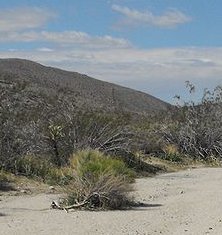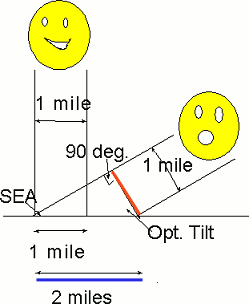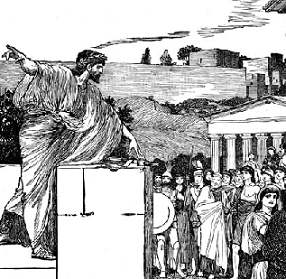This page is part of a series on insolation-factors.
An overview is provided at insolation.
The pages are:
sun angle,
air mass,
day length, and
clouds and pollution.
The solar radiation striking a horizontal surface is affected by the angle of the sun (the solar angle) which is in turn influenced by latitude, season and time of day. This page and its companion-pages, sa&i data and sa&i formula explain and quantify these relationships.
A lower sun angle makes the air mass value greater. Also, when the sun is lower in the sky all day (due to the sort of path the sun takes through the sky in the winter), the day length is shortened.

Both of these factors by themselves reduce the amount of solar energy a place receives in a day.
However, right now we are just concerned with the fact that when the sun is lower in the sky, its rays strike a horizontal surface with less concentration, lowering the portion of the insolation in the air that will be transferred to a horizontal surface.
This page explains why that is as well as why it makes winter cold and summer hot. Here we also explain why most of the time correctly tilted solar panels solar panels receive more solar energy than the ground.
On sa&i data we present and interpret a table that relates sun angle, air mass and the intensity of the sunlight striking a horizontal surface. We then relate this data to different areas of the world.
On sa&i formula we develop the exact mathematical relationship between sun angle and insolation.
The angle that sunlight strikes a surface affects how much solar energy is transferred to that surface.
If the sun is directly overhead, the angle of the sun above the horizon (called the "solar elevation angle" or "SEA") is 90° and the sunlight hits the surface directly. This is the best possible energy-transferring case.
At any lesser angle, the sun hits the surface less directly and less solar energy is transferred to the surface due to the "spreading-out" effect discussed below.

As illustrated by the drawing, if the sun is directly overhead, a square mile of sunlight covers a square mile of ground. However, the lower the sun is in the sky, the more ground the sunlight is spread out over.
The more spread-out the sun's rays are, the less concentrated they are and therefore the less energy they transfer to the ground or to any other horizontal surface.
If, to take the example of the lower sun angle in the picture, a mile of sunlight is spread over two miles of ground, the total solar radiation is halved. This means the amount of energy transferred to the ground will be halved.
Or, for another example, if a mile of sunlight is spread out over three miles of ground, the total solar radiation on the ground will be one-third what it would have been if the sun was directly overhead (see sa&i formula for the details).
This is why the lower the sun is in the sky, the less solar radiation falls on a horizontal surface (like the flat ground).
Since at latitudes far removed from the equator the sun's path through the sky is considerably lower in the winter than the summer, sun angle goes a long way towards explaining why winter is cold and summer is warm.
Your local environment is warmed when solar radiation heats the surface of the earth, and the surface of the earth then radiates some of that heat back out into the air directly above it. Lower winter sun angles mean less of the solar energy in the sky will be transferred to the ground, and this means less heat will be radiated into the air around you.
Furthermore, as touched on above, winter sun angles also reduce the total solar energy in the sky by making the air mass value greater and the day length shorter. Also, many climates are cloudier in the winter than the summer. All these factors come together to make winter so very dark and cold.
Because the sun starts very low in the sky in the morning, gradually making its way to its high-point at solar noon and then heading back down until it slips away at dusk, sun angle is also clearly a big part of why mornings and evenings tend to be the cooler parts of the day.

Of course, we can't do anything about winter except keep track of our mittens. However, as regards collecting solar energy, we can compensate for the angle of the sun by tilting our solar collectors so that they make a 90° angle with the sun's rays.
Look at the the picture and pretend that the red line is a tilted solar panel and that the blue line is a a horizontal solar panel.
The sun's rays are coming in perpendicular (at a 90° angle) to the tilted solar panel. The rays are hitting this panel directly and so a square mile of the sun's rays fall on a square mile of this solar panel.
This means the sunlight on the tilted solar panel will be as intense as if the sun was directly overhead (minus the intensity lost by the two related conditions we will discuss very soon). In contrast, the sunlight striking the horizontal solar panel is more spread-out and thus less concentrated--just like the sunlight striking the ground.
The optimal tilt angle for a given moment is the one that keeps the sunlight perpendicular to the tilted surface at that moment and is equal to 90° - (the SEA° at that moment). The diagram gives some idea of why this is. The math is more completely covered on sa&i formula.
Since the angle of the sun is constantly changing throughout the day, the optimal tilt angle changes from moment to moment. For this reason, the only way to fully compensate for the "spreading-out" effect of lower sun angles is to constantly track the sun. However, a correctly chosen permanent or seasonally adjusted tilt can greatly increase the amount of radiation falling on a solar panel.
The "spreading-out" effect only applies to direct radiation and so when the sky is completely overcast and all of the solar radiation is diffuse radiation, you would actually gather more solar energy by just laying your panels out flat (see types of radiation).
We have several pages devoted to tilt angles.

Tilting the collectors can't do anything about two other consequences of
a winter sun angle:
1. When the sun is lower in the sky, the extra atmosphere
the sunlight has to pass through reduces its
strength before it ever even reaches our solar panels
(see air mass).
2. The general
loss of sunlight due to shorter days reduces the amount of total radiation
in the sky on a given day (see day length).
Also, as we noted above, tilting solar panels actually reduces the amount of diffuse radiation you gather. In some very cloudy climates like Northern Europe, diffuse radiation can account for about half of the total radiation in the sky (see types of radiation).
On sa&i data we present and interpret a table that relates sun angle, air mass and the strength of the sunlight striking a horizontal surface. For reasons explained on that page, though the table takes air mass into consideration, it does not factor day length in.
On sa&i formula we develop the exact mathematical relationship between sun angle and insolation.
Updated: 2/17/2015
Hey!
We never interupt content with ads.
How rare and cool is that these days?!
Help us keep it that way by using the share button below:
The "not-interrupting-content-as-promised", side links below are not paid ads. They are personal recommendations from David Watson, who is wise and thoughtful:

Visit B Willard's
Lonesome Design Shop

